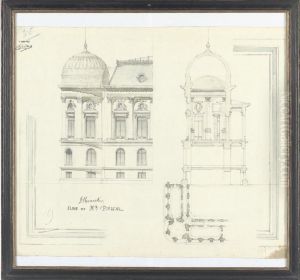Joseph Hornecker Paintings
Joseph Hornecker was a French artist, born in 1873 in Nancy, France, a region known for its significant contributions to the Art Nouveau movement. Hornecker's career spanned the late 19th and early 20th centuries, a period that saw considerable evolution in European art, moving from the ornate styles of Art Nouveau to the more abstract and expressive tendencies of modernism. Despite the shifts in artistic trends, Hornecker maintained a distinctive style that married architectural precision with a nuanced sense of decorativeness, making his work a unique contribution to the art of his time. Hornecker's education and early career were deeply rooted in the artistic traditions of Nancy, a city celebrated for its vibrant artistic community and its role in the development of Art Nouveau. He was closely associated with the École de Nancy, a collective of artists and architects who were pivotal in promoting the Art Nouveau style, characterized by its organic forms, flowing lines, and emphasis on natural motifs. Hornecker's work, while embodying these characteristics, also hinted at the emerging styles that would dominate 20th-century art. His ability to adapt and experiment with new styles while maintaining a connection to the traditions of his home city was a hallmark of his career. Throughout his life, Joseph Hornecker contributed significantly to the architectural and decorative arts scenes, both in France and internationally. His works include a variety of media, from architectural designs to decorative objects, showcasing his versatility as an artist. Despite his diverse talents, Hornecker is perhaps best remembered for his contributions to architectural projects, where his keen sense of design and detail could be fully realized. His legacy is that of an artist who bridged the gap between the old and the new, seamlessly integrating the flowing lines of Art Nouveau with the emerging modernist aesthetic. Joseph Hornecker passed away in 1942, leaving behind a body of work that continues to be celebrated for its originality and its contributions to the transition between major artistic movements. His life and work remain a testament to the vibrant artistic culture of Nancy and its influence on the broader artistic landscape of France and Europe during a period of significant change and innovation.
